Did you know that baby housemartins speak in their sleep? I did not ― until some nights ago in early July.
I was walking down the deserted main road outside Varese Ligure, an old-fashioned Italian mountain town. It was the evening of the day I had arrived. Following the dimly lit street, I passed a 1950s building with single-storey flats above some workspaces, derelict farming machinery lined up in front of the glass doors ― those narrow Bertolini tractors where the driver’s seat and the motor are articulated to allow manoeuvering steep Apennine meadows.
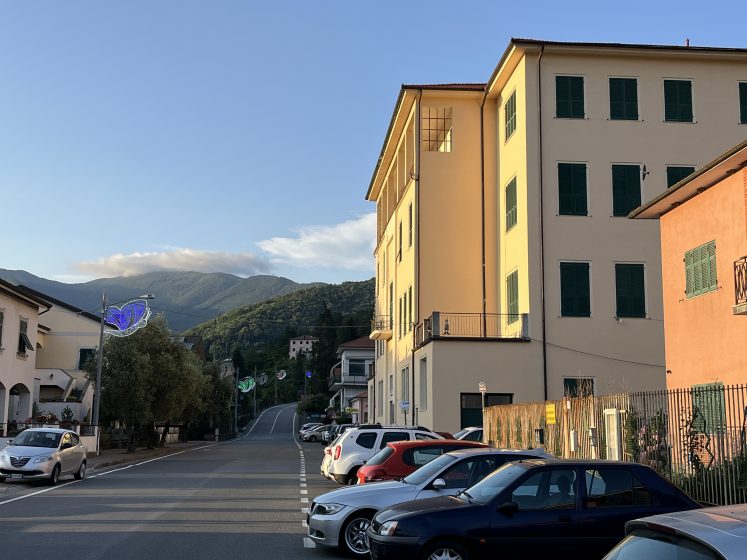
I registered the faint chatter when I came upon the next building, equally constructed in that distinctive Italian postwar style, a high multi-purpose ground floor, and a second floor with tall windows, barred with green roller shutters. The house behind a rusty fence with a “no trespassing” sign is the local office of the Carabinieri Forestali ― the branch of the Italian state police that is doing ranger duties in state forests.
When I stopped outside the gate, I could hear the flowing, melodious, multivocal chirping much more clearly. I looked up at the weakly lit façade, following the flow of sound. And then I saw what seemed its sources: Right under the eaves, visible as dark bulging shapes in the twilight, hung a series of rounded cupules, firmly attached to the wall. The sound, I understood, came from a housemartin colony’s nests.
From their openings, soft high-pitched babble emanated, a dreamy chatter in a multitude of tiny voices. The street lay silent under the light of few lamps, the Apennine sky was huge and quiet, stars sprinkled across the black. The night smelled of hay and jasmine. There was darkness and tranquility, and the silvery ringing of the little birds in their mud cradles, like tiny rivers flowing towards an invisible stream.
The sound touched my heart. Was there anything more innocent, more carefree, more trusting than the young bird’s murmur in their precarious housings, two storeys above the concrete ground? Their voices felt like a hidden source of sweetness welling up in a vast silence. The sound plunged me into a sudden trust, coming from some unknown place, regardless of how everything looked.
I had greeted the housemartins already earlier on that arrival day, in the oblique evening light, watching them circle through the transparent mountain sky. I was relieved that they were still here, their nests hanging untouched under the police station’s roof, right as last year when I left them. I felt relief that life was still perpetuating itself.
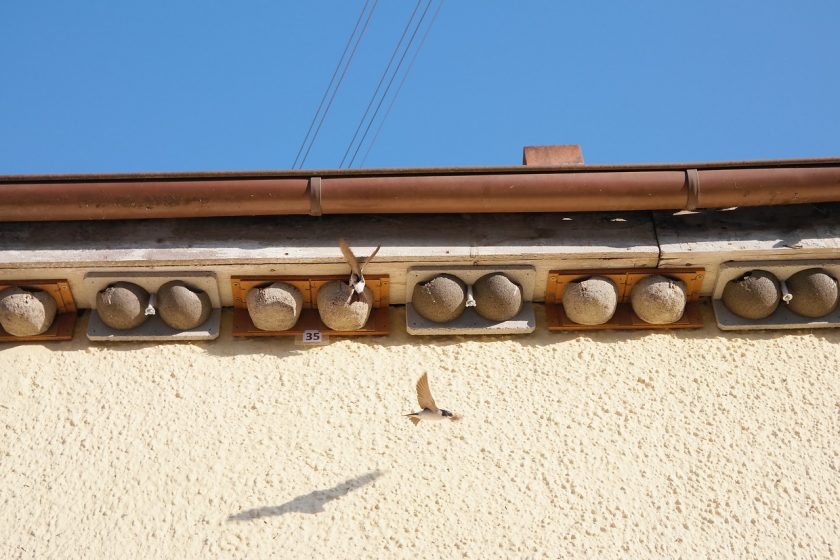
This life is embodied in 15 cm long, black and white feathered bodies, each weighing not more than 20 grams, with wings spanning about the length of a letter sheet. Their existence had flown steadily from the last summer into this one, as it was supposed to be.
Human interference had inflicted no visible damage to the colony. Its members had survived two globe-spanning journeys. Last September they had crossed the Mediterranean southward, then headed across North Africa, the Sahara, and the vast stretches of the African continent towards the Cape. In late winter they had started to fly back north again. And here they were.
Housemartins are swallows. They populate the whole northern hemisphere. Ornithologists estimate their numbers to be several million across the European continent alone. The tiny acrobats of the air are still a sort of everyday bird. You can expect to meet them in the Italian summer. But that does not mean that the shadow of decline is not cast over their daily business. I could not find reliable numbers for Italy apart from the notion that populations are decreasing. In Germany, the species is officially counted as “endangered”.
Housemartins have not always settled on houses. They are a rock-dwelling species, and some still nest on natural stone surfaces. In Tibet, housemartins can be found breeding on towering mountain cliffs up to an altitude of 4600 meters. Human dwellings made of stone supply a suitable ersatz nesting place for rocky cliffs. They do so for other birds who chase the air for insects, e.g., for the housemartin’s close cousin, the long-tailed barn swallow, or his distant relative, the large-winged swift. Attracted by the artificial rocks provided in the form of buildings, swallows and swifts followed humans into dense settlements and even big cities.
Over the centuries, the melodious chatter of swallows, together with the sharp cries of swifts, has become a common element in the soundscape of bigger and smaller settlements. Once housemartins were a common sight even in London. They vanished from there after the air pollution had become too severe ― but recently turned back to a now cleaner sky over the British capital.
From my childhood years at the northern fringe of Hamburg, I remember that both barn swallows and housemartins nested at seemingly every farm. Barn swallows build their homes inside the buildings, and housemartins on the outside, under the roof. The birds’ sharp swirlings, curving in right over my head, their chatter and chirping were part of the sweet presence of summer. They somehow constituted a thread in the fabric of reality itself ― like the sand between my bare toes, like the sinking evening sun, setting the grass pannicles aglow, like the July air, tender and inviting. Housemartins were part of the welcoming structure of the cosmos. They were exponents of life’s promise to never end.
Birds who hunt the skies for food catch the tiny insects that are part of the “aeroplancton” ― little beings who are drifting with the wind and welling up with air currents. Housemartins eat mites, mosquitos, aphids, little flies and occasionally overwhelm bigger prey like butterflies. They swallow their food while flying unless they are not feeding their young. Then they store the insects they caught in their crop. Once back at the nest, clinging to its rough outside with their claws, they push the food into the wide-open beaks of the little ones which peak eagerly through the opening of the mud cupule.
Every day, now, I stand under the birds’ nests for long stretches of time. I come and take satsang with the housemartins. I drink in the life that unfolds, life that is put together from what is necessary to do in order to create life. This necessity unfolding above my head without questioning has its own irresistible grace: Each bird is a “soft animal” allowing its “body [to] love what it loves”, as the Mary Oliver’s famous line (in Wild Geese) goes.
Now, in July, the chicks in the nest are already the second generation of this year’s offspring. Many of the birds feeding the nestlings are probably their slightly older siblings from this year ― a particular culture housemartins have developed to raise their young more securely.
The colony under the police station roof is rather large. More than two dozen mud balls cling to the wall under the eaves. In the night, all is silent, apart from the soft baby bird chatter. During daytime, there is a constant coming and going of birds. The air in front of the orange building resembles the bustling village square on a market day’s morning.
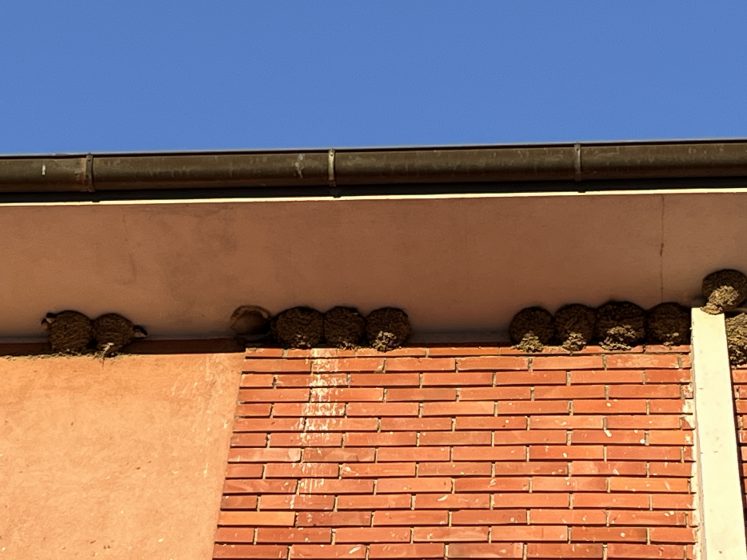
I stand there early in the day, my muscles swelling under the dance of the birds through the “clean blue air” (Mary Oliver). I come back in the heat of noon, while the adult housemartins relentlessly swirl around the nests and carry out their feeding business. I watch after sunset when the blue air is vibrating from wings like an ocean brimming with plankton.
* * *
Housemartins and other swallows, as well as swifts and bats, are directly linked to the availability of insects. The more chitinous bodies are floating through the skies, the easier it is for the flying predators to feed their young. But the air is less and less filled with life. As anyone riding a car in summer witnesses, the windshield remains clean for a long time. Insect density has drastically fallen. In Europe, their biomass is down by nearly four-fifths compared to 1975. Imagine a supermarket with only 20 percent of the shelves remaining filled with food.
Housemartins, although a staunch follower of human culture, are suffering from many sides. Lately, construction work during the summer and new, smooth wall coatings, create particularly devastating effects. In Italy, state subsidies have allowed energy-saving refurbishments of housewalls to peak. Often the builders don’t care, or don’t care enough.
In the provincial capital La Spezia, a ninety-minute bus ride to the sea from Varese Ligure, two winters ago reconstruction work on a city apartment block led to the destruction of all housemartins’ nests on the façade. Only thanks to the intervention of residents, artificial nest cupules from concrete were installed under the eaves, leading to a successful breeding period.
In Italy, all bird nests are safeguarded by law ― and housemartins (as barn swallows and swifts) are a protected species anyway. Not all municipalities, however, act accordingly. Homeowners sometimes even hack down the nests, as the birds create dirt going about their business of raising their young.
In Varese Ligure, I have discovered two new mud nests on another building some distance from the police station. Traces left by the birds are clearly visible on the wall. Every time I pass under that house’s roof, I hold the air. But, so far, the owners have not interfered, and I am grateful.
I know that always something bad can happen. Not because I have a pessimistic mindset ― but because it empirically does. Even if a species is doing halfway well, its life is precarious, and a little change can extinguish its local presence. The dread is not subjective, but objective. It has become a feature of our daily reality, which therefore runs counter to a profound truth: the trust-inducing generosity to give life. This creates painful cognitive dissonance.
Swallows need natural water bodies in order to form the mud balls that they roll in their beaks with the help of their saliva. They put their nests together brick by brick ― about a thousand beaks full of mud are needed to form a cupule. Earlier this year massive excavators dug up the shores of one of Varese’s two rivers and secured them with heavy boulders against potential flooding ― taking away some of the little mud ponds along the stream. It was only a little move towards more regulation, more order, and less complexity. It will not drive the housemartins out of town. And yet it was one more of the endless number of needle stings that the other-than-human beings have to endure, one more little scare in the atmosphere of dread.
Why does the owner of the small house on the road above the town mow the embankments every two weeks, cut down the diversity of flowers that distribute their sweetness to butterflies, bees, beetles, hoverflies, all those beings that create the soft skin of the earth? Another need for order, another desire to keep things controlled ― and it plays out as yet one more needle sting ― into my heart, and into the heart of life too.
Sitting with the housemartins is my medicine against these sort of experiences, although they are not immune against them. The housemartins are my allies against the rampant heartlessness with which people treat the world. They are suffering from it, too, but the suffering does not diminish their grace.
I am still wondering why swallows and swifts convey to me such a feeling of lightheartedness and inspire so much confidence. Is it for the reason that they do what they need to do, at the same time dogged and effortless, as though there was no labour at all involved, revealing that, in the end, everything meaningful is endlessly simple? Is it because their existence seems to be a dance from beginning to end?
The gracious flyers in the blue create a shortcut between inner dimensions and the material all life is made of. They prove that matter is desire, that the world of flesh and blood and rock and air and mud is at the same time a deeply felt experience. They show without words, without concepts, that sweetness is the other side of gravity. They are tiny bodies with fast beating hearts and delicate plumage, and they are the joy that sits at the source of everything that arises, the joy that is nothing else than the pure, direct experience of being, unhindered by thinking, by worrying, by any abstraction. Housemartins are, and this being is the smile of the world.
It seems that the birds manage to follow the old Zen proposal: do everything you do with one hundred percent dedication, do it with the sense, that you are fulfilling a sacred action. Do your dishes as satsang, too. When we acknowledge that even the most repetitive task done is a profound engagement with divinity, then everything becomes divine material. You are immersed in it. There’s nothing that is not the smile of the world.
The biggest housemartin colony I know of is spread out under the eaves of a Buddhist temple. The building is not in Asia, it is in Italy, too, in the Tuscany Hills, shaded by old umbrella pines. From its windows, you can steal a glance of the ocean’s silvery surface. The monastery was founded by a close follower of the Dalai Lama. It is one of His Holiness’s most favored temples outside India, so the saying goes.
The main building where the birds nest, is an old Tuscan villa, which has been adapted to the monastical needs, prayer flags fluttering across its courtyard. Beneath the imposing building lies a row of stupas, their cupolas magically recreating a Himalayan atmosphere in the Italian hills.
During summer school at the monastery, I used to sit on a bench in the courtyard every evening when the sky’s bright blue turned into the soft orange of the Mediterranean dusk. I watched the elegant circles and ecstatic loops hundreds of housemartins described in the air, swirling around the monastery, dancing above it, industriously returning to their tiny nest cupules and feeding their young. The mud nests were lined up one after the other between the roof beams, around all sides of the villa. I counted more than fifty breeding cupules.
On one of those evenings, I realized that the Buddhist monastery did not belong to its human inhabitants. In reality, it was the temple of a thousand stupas, where housemartin worshipped life. Humans dreamt of spiritual realization here. But it was through the little creatures of the air that realization happened. Every curve of flight, every catch of prey, every gift of food to their babies was incessant devotion, full of chant and dance. The housemartins were completely without thought, they surrendered without question. They allowed being to be.
Andreas Weber
Berlin
On The Nature of Cities

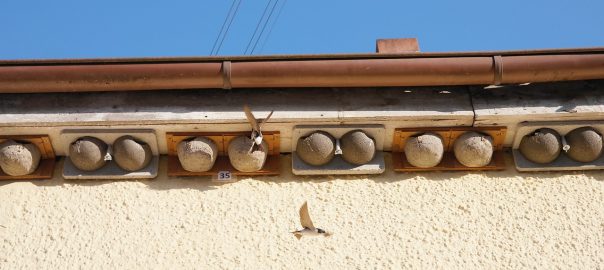


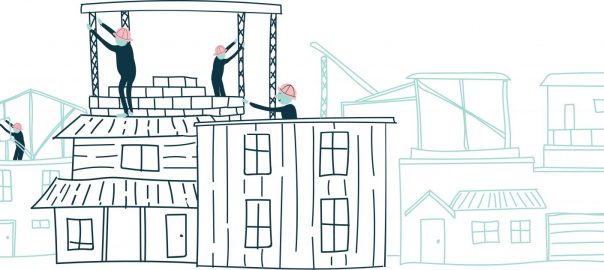
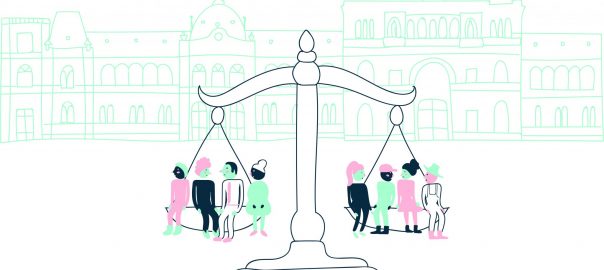
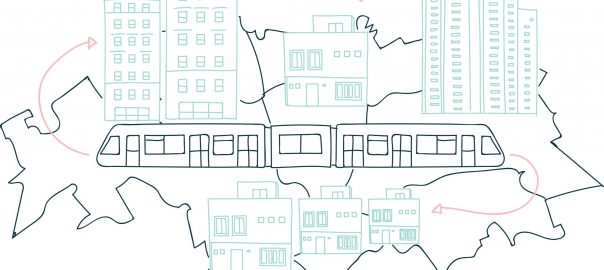
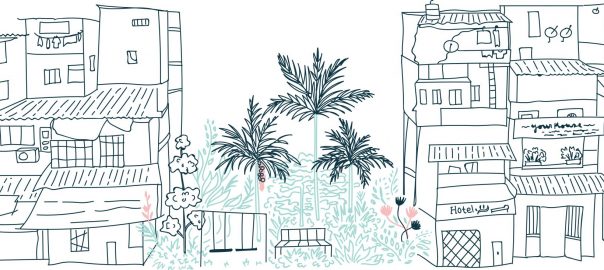
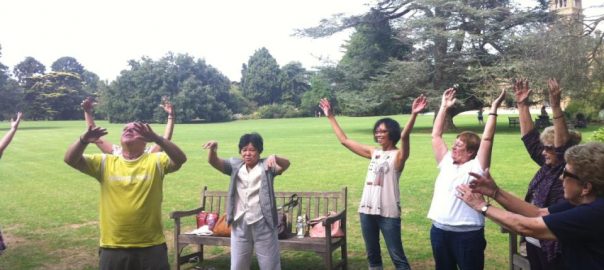
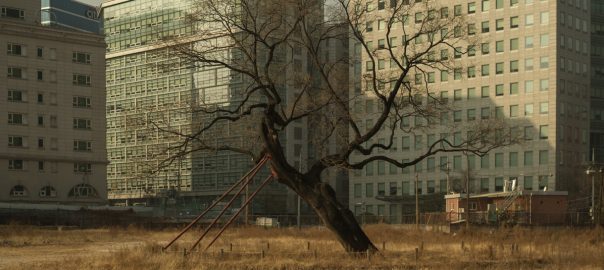
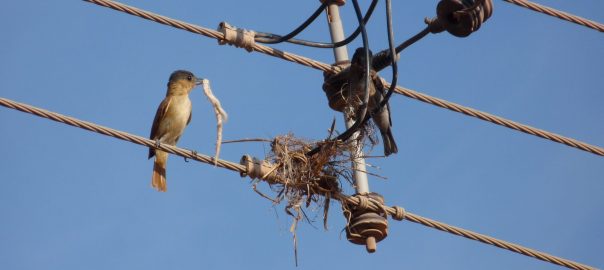
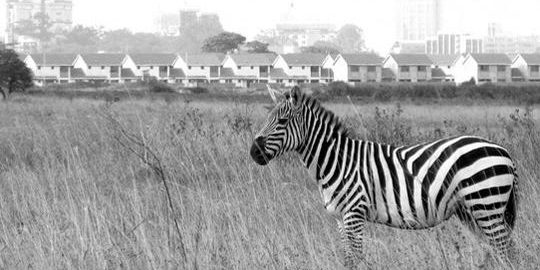
Add a Comment
Join our conversation